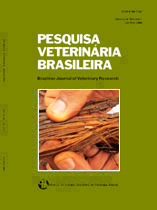 |
|
|
|
Year 2013 - Volume 33, Number 6
|

|
Conditioned food aversion for the control of poisoning by Ipomoea carnea subsp. fistulosa, 33(6):719-723
|
ABSTRACT.- Pimentel L.A., Maia L.A., Carvalho F.K.L., Campos E.M., Pfister J.A., Cook D., Medeiros R.M.T. & Riet-Correa F. 2013. [Conditioned food aversion for the control of poisoning by Ipomoea carnea subsp. fistulosa.] Aversão alimentar condicionada para o controle da intoxicação por Ipomoea carnea subsp. fistulosa em caprinos. Pesquisa Veterinária Brasileira 33(6):719-723. Hospital Veterinário, Centro de Saúde e Tecnologia Rural, Universidade Federal de Campina Grande, Patos, PB 58708-110, Brazil. E-mail: lucianoanp@yahoo.com.br
Conditioned food aversion is a technique that can be used to train livestock to avoid ingestion of poisonous plants. This study tested the efficacy and durability of conditioned food aversion to eliminate goat’s consumption of Ipomoea carnea subsp. fistulosa. We used 14 young Moxotó goats, which were initially adapted to the consumption of the plant by offering dried I. carnea subsp. fistulosa with their concentrate diet for 30 days, and then subsequently providing green plant for another 10 days. To confirm the spontaneous consumption of the plant, the goats were allow to graze in a paddock of 510m2 where I. carnea subsp. fistulosa had been planted in an area of 30m2 (10 plants/m2). On day 42, 12 goats were offered fresh green plant individually in a pen for a few minutes, and after the consumption of any amount of the plant they were treated orally with a solution of LiCl at a dose 175mg per kg of body weight. This procedure was repeated for two more consecutive days. Thereafter, the goats were divided into two groups: Group 1 with four averted and two non-averted goats; and Group 2 with eight averted goats. To verify the efficacy and duration of aversion, both groups were introduced into the paddock with I. carnea subsp. fistulosa three days a week for two hours daily. In Group 1, with two non-averted and four averted goats, all animals started to ingest the plant after 1-6 weeks of grazing. They continually increased their consumption of the plant, but never consumed the plant exclusively. None of the goats of Group 2 goats started eating the plant during the 12 months of observation. After this period the area of the paddock planted with I. carnea subsp. fistulosa was expanded to 80 m2 and grazing time was increased to four hours per day for five days a week. At this stage all the goats in Group 1 ingested the plant in large quantities. The goats from Group 2 gradually started to eat the plant and aversion was extinguished in all animals after two months. Swainsonine concentration of I. carnea subsp. fistulosa was 0.052±0.05% (mean ±SD). It was concluded that conditioned food aversion was effective in reducing goat consumption of I. carnea subsp. fistulosa, but the duration of aversion depends on the time of grazing and amount of plant available. However, the aversion was quickly extinguished by social facilitation when averted animals grazed with non-averted animals. |
| |
|
|
| |
|
 |